Abstract
The digital transformation means that companies are redefining the process of talent management. Previous models involved functions, practices and processes that ensured a correct flow of employees towards key positions or a generic talent management view. The digital breakthrough, together with the growing panorama of competition for talent in the market, requires a different focus to enable well-grounded and agile decision-making processes in a sustainable world. The current research considers the functions that applied research has established as the limits of talent management, and that are the key topics in an employee life cycle, namely, talent attraction and acquisition, training, evaluation, and development. In addition, new tools such as employee advocacy and/or brand ambassadors have been added towards to draw conclusions about the future trends of talent management. This article examines the employee life cycle of talent attraction, and acquisition, training, evaluation, and development in the study of the main digital tools utilized in the Spanish market, by both national and multinational corporations. The results indicate that future investments are needed to correlate the digital tools and take advantage of a better employee life cycle management. The main results show a rapid increase in the number and variety of tools used in the talent acquisition process, an expanded use of social networks to enhance the scope of those processes, and conversely, a minor use of digital tools for both talent development and talent retention processes.
1. Introduction
Literature reveals talent management as a dynamic concept. In this way, the attempts to find links between the various conceptions of the term itself bring substantial differences to light [1,2,3,4].
An added difficulty is defining what scope is covered when referring to talent management. Traditionally, talent management models were more permanent and remained focused in facilitating personnel development in organizations over time. Companies invested in employee training and personnel loyalty and commitment [5]. Based on this principle, the role of human resources departments was to support the entire working cycle of a company’s employees. This involved defining and managing all processes of selection, hiring, training, development, and promotion. The challenge was to reconcile the maximum level of employee satisfaction, while optimizing their performance. This traditional centralized model is replaced when employee turnover is increased, and retention rates decreased.
Digital transformation of the society is in full swing in the 21st century. While talent management could exploit both the benefits of applications, resources, and tools, and the viral nature of social networks, which are reachable anywhere in the world, the results achieved regarding talent management are not all that satisfactory [6]. The above is not in conflict with the sustainable development goals promoted by the United Nations.
The present study gathers an exploratory research of the level digital tools are being utilized for talent management by organizations in Spain.
Spain has continuously increased its GDP over the last forty years: while in 1980 it exceeded 159 billion, in 2019 it reached 1.24 trillion. The last economic cycle of expansion in Spain began in 1994 and ended in 2008, coinciding with the world crisis, with 15 consecutive years of growth [7]. Whereas in 1980, the Spanish population was 37,698,000 people, in 2019, the population reached 46,736,000 people [8]. This economic growth has generated jobs, even if, apparently, said jobs “do not always provide for dignified living conditions” [9]. The increased number of vacancies has nevertheless required local and international talent to fill the positions that have arisen.
The current research considers the functions that applied research has established as the limits of talent management, and that are the key topics in an employee life cycle [10], namely, talent attraction and acquisition, training, evaluation, and development. Regarding the inclusion of new tools in human resources management, employee advocacy and/or brand ambassadors, as a source of commitment and integration within the company, have been added.
The authors initiate this research with a literature review regarding talent management, and the debate around talent hunting in which organizations are currently being involved (the so named “talent wars”). Secondly, it is investigated possible modifications to the talent management concept, coming from the increased use of digital tools. In the third place, the results of the research are showed with the compiled data. Finally, this paper concludes with a discussion about how Spanish companies have digitalized their talent management process.
This article contributes to a better understanding about the employee cycle life and its procedures and phases taking advantage of the digital transformation of human resources management. There is an increasing digital development in Spain. This article, although how the digital tools of talent management are being used, show the strengths and the weaknesses of the digitalized functions of talent management. As a consequence, it could be explained why some digital talent management resources may lead to higher employee satisfaction, higher retain talent and, In addition, enhance sustainable development.
2. Literature Review
2.1. Talent Management
The word talent is used to refer to a personal skill, to the ability to work, or a competence that distinguishes one person from another [11,12]. Etymologically, talent is related to measurement units [13] or as a metaphor linked to a specific human condition, occasionally innate, that may be exploited and developed. Its Biblical origin was much more open to personal interpretation [14,15,16]. Historically, its first use regarding a person dates back to the late 19th century [17]. Finally, in its semantic aspect, and within the context of the world of labor, we may speak of “superior job performance” [18]. About its evolution, it is worth signaling that more than 90% of articles published in indexed journals for talent management have been written within the last ten years [19].
The Industrial Relations Section of Princeton University [20] established a five-stage model of internal talent development inspired by the US Navy, which consisted of organization analysis, selection, evaluation, development, and inventory control. Cochran [21] summarizes the difficulty faced by large American corporations, in the first half of the last century, when seeking the top executive profiles for their companies: “…How were men to be trained, selected, and inspired to undertake the task of coordinating and directing the enterprise as a whole?” This system evolved in the period between the years 1950 and 1980 [22], and the goal was to cover the needs of the most strategic positions, through a variety of processes and systems. Lately, because of the uncertainty of the environment, companies started feeling the need to search talent outside to remain competitive, and this talent search is currently no longer exclusive to strategic positions. Today, talent search is extensively developed at intermediate levels [23], and therefore widens the frame concept for talent management itself.
The most important talent management decisions are currently being taken within a rapid and dynamic environment, with uncertain as well as very competitive global movements [24]. Lewis and Heckman [3] point to the wide use of the term, as well as to the difficulty to find a single definition, given the variety of meanings ascribed to it by the different authors, a difficulty shared by the definition of talent itself. They also distinguished between three different approaches: 1: a new denomination comprising a set of different human resources functions and practices (i.e., selection, development, and succession plans) aiming to a more agile and rapid management, and valid across sections; 2: a process that ensures a correct flow of employees towards key positions, progressing in different positions (more focused on succession but without ignoring selection); or 3: a generic talent management view, disregarding the company’s limitations or needs, and hiring the best talent possible.
In the early 21st century, Capelli and Keller [18] estimated the term “talent management” to be the most used in the field of human resources and offered an optimistic view regarding the possibility of reaching an ample consensus around it. They pointed out an increased move towards exclusive talent management (as opposed to inclusive), promoted by the unequal performance and value creation by the different employees, which also appears justifying a different investment in each of them.
2.2. From People to Positions. Not Just Any Position: The Key Positions
In their definition, Collings and Mellahi [4] focus on key positions that give a greater competitive advantage to the company and endorse Lewis and Hechman’s [3] complaint regarding the lack of clarity in defining the term. The authors warn that key positions should not necessarily be related to those with the highest responsibility. Vaiman et al. [24] provide a more updated view of talent management, which includes the need for data, measurements, and analysis in the decision-making process and to achieve greater efficiencies.
Factors currently contributing to the relevance of talent management are quite varied, and among them, we may distinguish, demographic changes, diversity, continued globalization, the appearance of the Knowledge worker, and internationalization or global mobility [19]. Although our aim around prolonging the employee life cycle is clear, “ensuring you recruit the right employees in the first place” [10], these previous factors condition the company’s capacity to recruit and retain talent and question the effectiveness of former models in achieving this goal, even more so if they are neither efficient nor sustainable.
The challenges identified by Capelli and Keller [18] for the coming years are divided into three: a more efficient and persuasive internal development to retain talent, internal mobility as a career goal for employees, and integrating new external solutions. Collings, Mellahi and Cascio [25] highlight the need for researchers to confront one of the biggest challenges of organizations by building effective channels to improve talent management.
Different surveys completed by managers in large corporations [26,27,28,29] highlight the concern for attracting and retaining talent, availing of the required skills and abilities, and at the same time, identify obstacles to its achievement. However, the results regarding the limitations to achieving the said goals are not conclusive. The so-called high performers may be 400% more productive than the average employee [30] and, in the case of complex jobs, this performance difference may be as large as 800% [27].
Talent does not appear to be a uniformly distributed raw material; an investment is needed to balance the differences, and the diverse performance levels create an imbalance leading companies to constantly seek out the differential value between employees and potential candidates.
2.3. The War for Talent
The characteristics of talent may be measured according to the skills that are being assessed for each position. Chambers et al. [1] believe that being talented is not enough. Companies must prioritize talent management, identify the motivation behind the talent attraction, where to find the needed talent, and create a winning value proposition for employees. The goal is both related to retain and to attract the right talent.
Employees activity is reviewed in their performance management. Capelli [31] gives more importance to concentrate the retention effort to certain employees. O’Boyle and Aguinis [30] sustain that the hiring or leaving of a talented employee can have significant consequences on the overall productivity of an organization. This approach, promoting exclusive talent and focusing talent management towards top performers, attempts to demonstrate that these employees make a disproportionately high contribution to the development of the company [18]. This company debate on talent, high performance and results underscore the challenge faced by talent management systems in their quest for efficiency.
The title of the research “The war for talent” [1] foretold a serious situation. It predicted that in the coming years, large corporations would fight an arduous battle to recruit and retain the best talent. They would be competing with start-ups and increased mobility. A few years later, in 2006, a similar study concluded that finding talented employees would be a major concern in the coming years, and at least half of the companies considered that the competition for hiring the best talent would become even more cut-throat [32]. McDonnell et al. [19] pointed out that the consideration of human talent, as the most valued company asset, places greater responsibility to the attraction and retaining processes of key employees.
Talent is scarce [33]. In 1998, only 23% of the 6000 executives interviewed by McKinsey believed that their company could recruit talented individuals. In the Conference Board of 2016, only 23% of managers and executives believed that their hiring and attraction strategies would work. The difficulty of ensuring the loyalty of newer generations [34] or the complexity of making attractive offers, in addition to the effects of globalization, adds to an environment of uncertainty and dynamism. Talent has no barriers to traveling and to mobility in the search of a more attractive project.
Companies seek to have the best talent available. This need goes beyond the human resources department to become a key asset of a company strategy. Huselid [35] illustrates a beneficial relationship between HRM (Human Resource Management) and SHRM (Strategic Human Resource Management), as when the management of human capital is elevated to the company strategy level, it improves company performance.
Companies may design their own strategy offerings to capture the best candidates, as well as to allow for growth and development of their employees. Digital technologies have become key players in these processes, thanks to the reach of their resources and tools.
2.4. Digital Transformation
In 1981, the Transmission Control Protocol/Internet Protocol (TCP/IP) was defined, and the word Internet was coined. In 1991, the appearance of the World Wide Web was announced. The first email service Hotmail dates back to 1996. In the 1990s, there were 64 kbps RDSI networks. Currently, the 5G network allows the exchange of information at 20 Gbps, at speeds that are 300,000 times greater than the 1990s speeds. Data travel every day at greater speeds and in increasingly large chunks. Digitalization is also connected to the globalization phenomenon, increase the speed of change, but above all, we must highlight “the potential of digital technologies to enhance value creation” [36]. The progressive digitalization of society affects companies and consequently, talent management, “leaving no part of HR untouched as it radically changes the types of services offered by HR and how they are delivered” [37]. Human resources management has been transformed into e-HRM (Electronic Human Resources Management), and consists of online-integrated systems for HR management manageable from anywhere.
Digitalization generates a positive image towards the talent to be attracted, ensures employee commitment, gives employees’ and departments’ greater autonomy and accelerates the implementation of new roles in people management [38]. To reach that conclusion, they analyze different types of organizations and they found concrete examples of digitizing HR services around the year 2000. The authors, nevertheless, conclude that the decision to opt for digital technology is based on the firm will to build a more efficient infrastructure for the administrative or basic role of the function in question, and not so much for a strategic use of the tool. Human resources does not perform a true strategic role and, therefore, it does not seem logical to seek this functionality when this role does not officially belong to the HR department. There is evidence that HRM improves with the incorporation of e-HRM. Technology is applied to simplify the recruitment and selection process [39], to avail of social networks as means to attract job candidates [40,41], or for unemployment management [42], payroll management, and other related activities [43]. However, there is no proof that e-HRM improves HR decisions or its capacity and results when they are used strategically.
E-HRM technology shows a hope to improve Human Resources management. Some of its benefits may include making work more efficient and effective, lowering costs, accelerating process and avoiding bureaucracy through automation [44]. To this may be added costs savings related to the management of the function, strategic alignment, and improved associations with current practices [45] as well as transformative potential [46,47] in its hypothetical role and as an agent of change in the company.
E-HRM is also related to operational achievements, relational and transformational goals [48]. Concerning internal or external clients, both found objectivity perception or increasing company attractiveness.
Definitely, digital transformation has just begun for companies. That means disruptive responses to add more value to the services they give and to the processes they manage [49]. Digitalization only means to introduce new tools belonging to information and communication technologies. Organizations will change the concept of the workforce, the workplace, and as a consequence, the world of work [50]. Working from home, as an example, is not only working from home thanks to ICT; companies must define a new culture, new roles, new contracts, new teamworking roles, new leadership, etc. The potential for the digital transformation requires in-depth changes to company’s systems and new working formulas. Talent management is also a part of this process. The potential for the digital transformation requires in-depth changes to company’s systems and new working formulas. Talent management is also a part of this process.
2.5. Talent Management and Sustainability
Sustainability is defined by The World Commission on Environment and Development [51] as “development that meets the needs of the present without compromising the ability of future generations to meet their own needs”. Decent work and economic growth, one of the sustainable development goals defined by the United Nations, has plummeted because of COVID-19. Unemployment, wages, and gender gaps have all suffered the socio-economic impact of the pandemic.
Women and young people have lost the most jobs because of the pandemic, increasingly if they were employed within the informal economy [52]. In March 2020, the United Nations alerted that the pandemic was attacking the heart of our societies. It is necessary to maintain quality education for children and young people and to stimulate the economy, boosting small and medium enterprises, and helping informal economy sectors [53]. Education uses resources and efficient and sustainable efforts to generate future talent. Corporate feasibility encourages the psychosocial development of people.
The traditional business paradigm reenforces the idea of increasing financial returns or maximize the shareholder value, but HR should work in order to achieve greater goal, sustainability [2], providing good long term economics, reducing externalities and reducing barriers that limit the development of future generations.
In periods of economic contraction, when we find social barriers that are increasingly difficult to appease, finding solutions that optimize available resources, increase the loyalty employee, and increase talent retention, will be well received. Alves, P. et al. [54] show that retention strategies based on compensation and benefits are less effective than those based on increasing affective organizational commitment through generating greater identification with the organization through Employer Branding and that one may create a proposal of value for employees, where culture is the most sustainable element.
Organization sustainability keeps a close relationship with a talent management process focused into recruiting, selecting, developing and retaining employees [55]. The authors find that transparency and consistency at the talent acquisition process, contributes to corporate sustainability. Aware of the importance of talent management and its critical role in the performance of organizations, companies need good practices that are not so leveraged in increasing the salary cost.
As a consequence of this previous discussion, we have considered the use of talent management or talent acquisition or may be talent retention. According to literature, there are different positions: focus on the best talent, align the company strategy to the human resources strategy, or define a standard process for all the staff without not depending on the former talent. Finally, we have chosen talent management, in order to know how to define a standard process using the information and communication technologies. People have the same opportunities to take advantage of all measures a company gives. We prefer to keep this last focus so as to understand the human resources digitalization process and the different measures defined by a company.
3. Methodology
This research was generated from the need to understand the degree of digitalization in talent management processes in Spain, related to its sustained economic growth and the increasing digital transformation process. It stands up from the need to know how the factors of both talent and digitalization are currently linked to each other and how companies react to them.
The field of application of the current research is based on Chambers et al. [1] considerations, focusing on the following processes: employee recruitment, attraction, training, assessment, and development. It compares the results with the related existing literature and determines what the main functions are for the employee life cycle, which can benefit from the use digital tools.
According to the National Statistics Institute [56], Spain has 3,363,197 companies, of which 25,165 employ a staff of more than 50 workers, and 3,338,032 have a total of less than 49 workers. This study focuses on the first group, as they are more likely to be equipped with advanced tools for talent management and digitalization. Nevertheless, we have included a small sample of companies with a lower staff complement to compare the factors measured.
The information was compiled by means of an online questionnaire customized for the conditions and goals defined by the research group. This survey was performed in March and April 2019. The invited sample was 240 companies, and the final participating sample reached a total of 180 of which more than 30% are listed on the IBEX 35. Therefore, the results of this study have been obtained from an N = 180 organization sample. The geographical scope was Spain, although most of the participating companies belong to Madrid and the Basque Country. Tableau, a business intelligence and rapid analysis software, was used as the tool for data collection,
The survey was designed together by The Key Talent, ICADE Business School, and the Universidad de Deusto. The online questionnaire consisted of 22 questions, including both open questions and multiple as well as single-choice questions, formulated based on conclusions met, as a result of individual meetings hold with talent management leaders, in which the most critical processes were analyzed. The surveys were addressed to HR heads and/or departments, and talent management departments or management areas. All participating organizations submitted the completed questionnaire. The questionnaire was designed to facilitate progress in responses, exploring the entire talent management cycle.
The main goal of this research is to measure the degree of digitalization of the talent cycle in companies located within Spain, regardless of their origin.
4. Analysis and Results
4.1. Company Profiles
Companies participating in the study had an average staff total of above 200 workers, and together employed more than 500,000 people. A total of 50% of the companies employ more than 1000 people, 19.4% between 51 and 250 workers, 13.3% less than 50, 8.9% between 251 and 500, and finally, 8.3% had between 501 and 1000 employees (Figure 1).
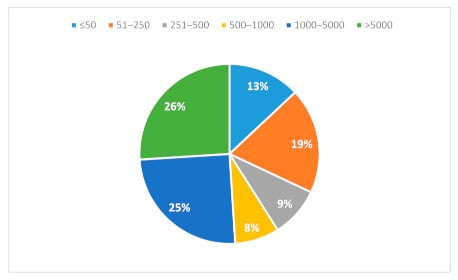
Figure 1.
Number of staff by company size. Note: Author’s own.
Eleven different sectors were represented in the study sample, as the main ones being industry, services, textiles, distribution, telecommunications, technology, and software, accounting for more than 50% of participating companies. A total of 53.9% of the companies are based in the Madrid Region, with a further 28.9% in Basque Country and 9.4% in Catalonia. The remaining 7.8% are distributed over eight different Autonomous Regions (Figure 2).
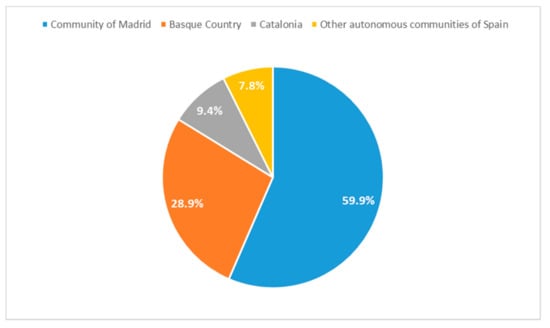
Figure 2.
Geographical distribution of companies by autonomous communities. Note: Author’s own.
4.2. Digitalization
Participants indicated how they perceived the degree of digitalization of their company regarding the human resources management process, using a Likert scale from 1 (“very low digitalization”) to 5 (“very high digitalization”). Only 25% of the sample believed that they had sufficient or very high digitalization levels, whereas 38% believed they had very low or low levels of digitalization; and the remaining third believed they were “somewhat digitalized” (Figure 3).
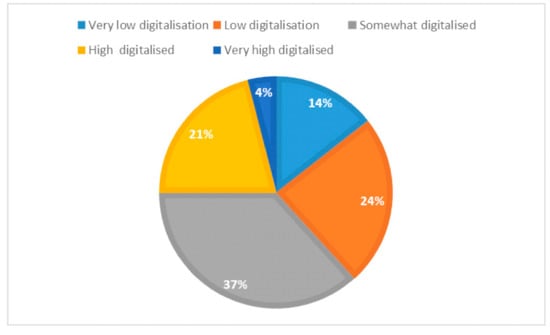
Figure 3.
Level of digitalization of companies. Note: Author’s own.
The surveyed companies were also asked about the level of use of each type of digital tool and a total ranking was computed, providing another indicator of digitalization (Figure 4). The total ranking was obtained from the sum of the partial responses. Each type of tool was weighted based on its relevance:
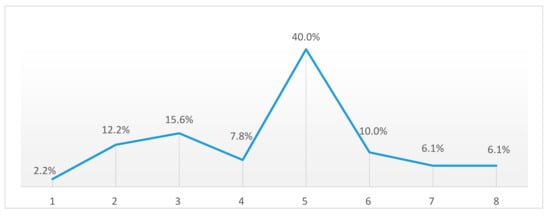
Figure 4.
Level of use of digital tools. Note: Author’s own.
- use of a corporate website (2 points);
- use of general websites (Infojobs, Yobalia, etc.) (1 point);
- use of specific websites (Secretaria plus, etc.) (2 points);
- use of professional social networks (LinkedIn, beBee, Glassdoor, etc.) (2 points);
- use of general social networks (Twitter, Facebook, Instagram, etc.) (1 point).
The results are shown in a graph, where the maximum score is 8 (highly digitalized) the minimum score is 1 (little digitalized). The distribution of the results is as follows: only 22.2% of the participating companies ranked the highest (between 6 and 8 points), a rank of 5 was scored by most companies (40%), and finally, 37.8% have a low level of use of digital tools in their company.
The companies with larger workforces (500 workers or more) tend to show the highest levels of digitalization (Figure 5), although the trend is not linear. On the contrary, the lowest levels of digitalization of talent management processes are concentrated in companies with less than 50 employees.
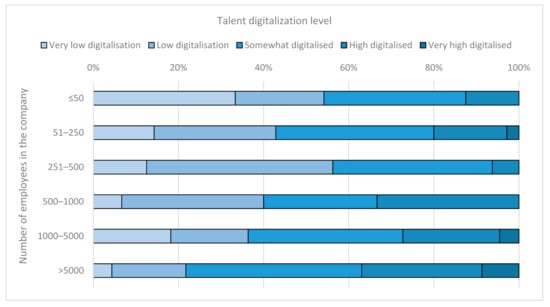
Figure 5.
Talent digitalization by sample size. Note: Author’s own.
The goal of investment in digitalization (Figure 6) is focused on improving the quality and reliability of selection processes. A total of 43% of the surveyed companies answered that, with digitalization, they seek to obtain candidate profiles that are better suited to their open vacancies. Time saving appears to be a second relevant factor and was considered by 37% of the responding companies.
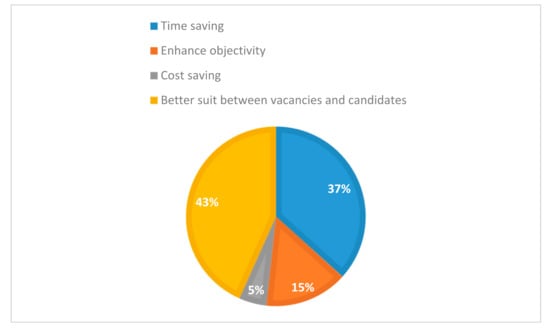
Figure 6.
Objective for investing in digitalization. Note: Author’s own.
4.3. Talent Management: Attraction
A total of 77.8% of the contributing companies resort to their corporate website as a basic support tool in their digitalization processes for talent attraction (Figure 7). Three in four of the companies also use employment websites. Specific job websites are used with a much lower frequency (14.4%). Professional Networks are the most frequently used resource (87.8%), with very homogeneous frequencies. Only 22.2% of the companies surveyed use social networks.
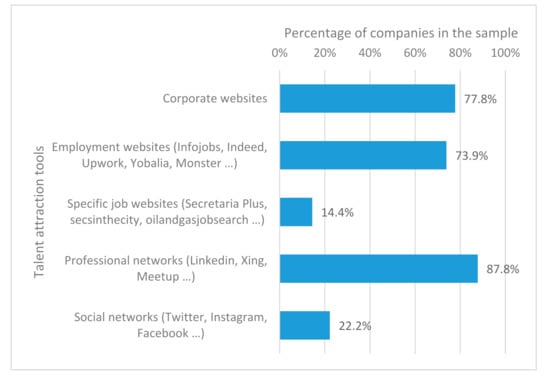
Figure 7.
Talent attraction. Note: Author’s own.
With regard to the company size and the channels for posting job offerings (Figure 8): 1: those with fewer than 50 employees published very few job offerings on employment websites and also few on their corporate websites; 2: employers with between 500 and 1000 workers do not post job offerings on specific job websites, but on professional networks; 3: companies with more than 1000 employees mostly use their corporate website, employment websites, and professional networks, and show relatively low use of specific job websites and social networks.

Figure 8.
Channels for posting job offerings. Note: Author’s own.
4.4. Talent Management: Talent Attraction Techniques
Regarding the technique used for talent review and whether this is in line with the company size, the traditional CV review is the most frequently used technique. This is notable for a company range of 251–500 employees. Meanwhile, killer questions predominate in companies with 51–250 workers, and machine learning and chatbots are used symbolically.
4.5. Talent Management: Selection Procedures
ERPs (Enterprise Resource Plannings) and company DBs (databases) are the most frequently utilized tools (Figure 9). Companies with more than 1000 employees use ERPs most frequently, in comparison to companies with less than 50 workers, which practically never use it. Recruitment tools are also less frequently used in the smallest companies, along with those with a range of between 500 and 1000 employees.
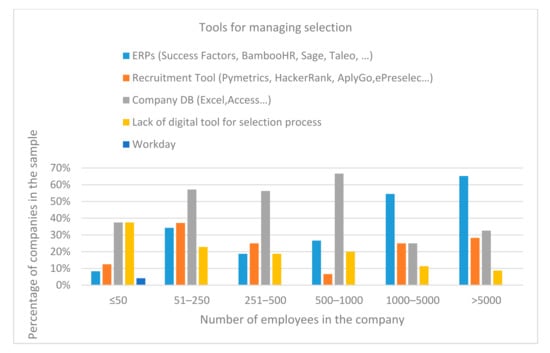
Figure 9.
Tools for managing selection procedures by company size. Note: Author’s own.
The use of digital systems for managing selection procedures is proportional to the size of the company. More than one-third of the smallest companies lack these systems, while this is only true for one in every 11 companies with more than 5000 employees.
4.6. Talent Management: Online Assessment
A total of 25% of the surveyed companies use online tests (Figure 10). This is observed to be somewhat higher in the cases of companies with more than 5000 employees (34.8%), and lower in companies with between 500 and 1000 workers (6.7%).
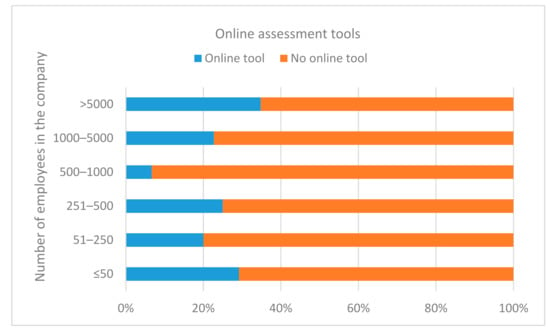
Figure 10.
Online assessment and company size. Note: Author’s own.
Regarding companies utilizing online tests (Figure 11), the most sought-after goal is to provide support for interviews (18.89%), with some differences, but it is always the end-goal in all companies regardless of their size. Support for decision making in performance assessment process (12.78%) and screening (12.78%) are less frequent goals of these tests.
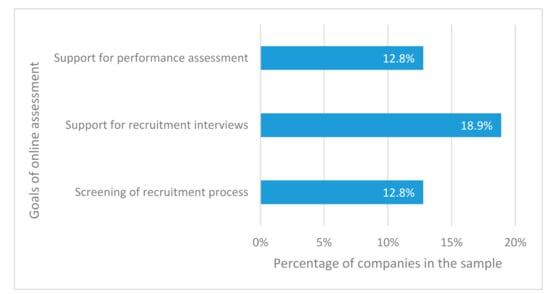
Figure 11.
Goals of online assessment. Note: Author’s own.
4.7. Talent Management: Digitalization of Training
Gamification (Figure 12) is used by 40% of the companies. While only between 23% and 33% of companies with less than 1000 employees utilize this method, more than half with more than 1000 employees do indeed employ gamification for training.
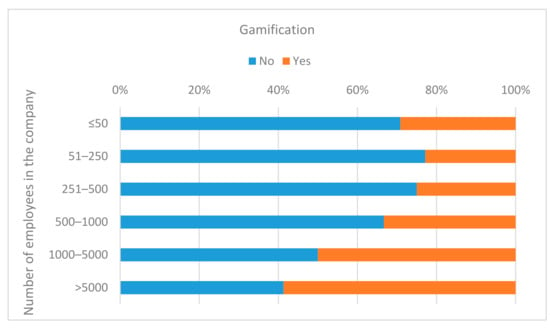
Figure 12.
Gamification and company size. Note: Author’s own.
Half of the companies that employ gamification in training activities (Figure 13) use quizzes and role-plays. Candidate rankings, rewards systems and challenges are used by more than a third. Other ways of gamification methods are little implemented. The five most used gamification methods are distributed as follows:
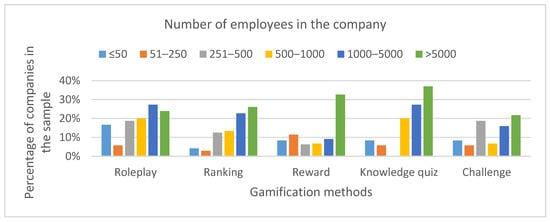
Figure 13.
Gamification modalities and company size. Note: Author’s own.
- The highest use of role-plays occurs in companies between 251–500 employees (75%);
- Rankings are more often utilized in companies with 250 employees (40% and 50%);
- Rewards systems are most frequent in companies with more than 5000 employees, as well as in those with ranging between 51–250 workers (50% or more);
- Online games are mainly used in companies with an employee count of above 500 (55% or more);
- Challenges are used in 75% of companies with a staffing between 251–500.
4.8. Talent Management: Employee Advocacy
There was little use recorded of corporate communication tools (Figure 14) allowing employees to share content through their social networks (15%). This is true for both corporations with more than 5000 employees (26%) and for the smallest companies (21%).
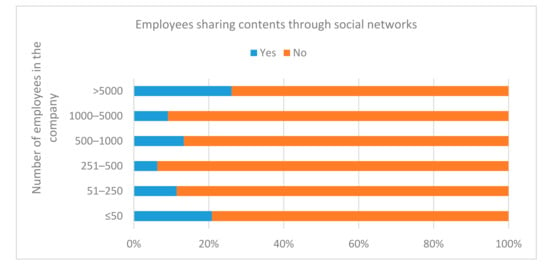
Figure 14.
Use of communications tools for pushing employees to share company contents in social networks and company size Note: Author’s own.
5. Final Considerations
The corporations that have been part of the research show similar results to those in the McKinsey’s study [6]. Nonetheless, these companies are incorporating digital resources into the talent cycle, that is, in detection, attraction, recruitment, and retention. The pace at which these are incorporated is different for each phase.
According to the results found in this research, the lack of technology tools affects hiring process as [57] express. The surveyed companies do not use online tests as other experiment have done [58]. Big companies are generally better prepared than SMEs. In addition, these kinds of companies must increase their own employer branding model. The low results in this research showed in this research should work as a nudge to improve their attraction and retention procedures as Monteiro et al. [59] show in their research. As soon as the companies improve their talent management cycle, with a broader investment in measures like employer branding, they will be able to offer a more attractive company at which to work [60].
The assessment of the current situation shows a continuous growth, with a wider use of media in the stages of detection, attraction, and talent acquisition, as stated by Schalk et al. [38], mostly since this enables companies to appear attractive and reinforces their brand image. This reinforces the value added of introducing the employee advocacy and ambassador brand in the research as new items to consider in the talent management literature.
This research has established as a limit of talent management and key topics in an employee life cycle [11]: talent attraction and acquisition, training, evaluation, and development. In addition, new tools such as employee advocacy and/or brand ambassadors have been added so as to draw conclusions about the future trends of talent management. The results show growing trend of companies using professional social networks to search for the needed talent [40,41]. On the talent assessment stage, they still prefer to use more traditional methods, such as in person interviews. Once the candidate becomes an employee, direct and face-to-face communication predominates over other means, although there is an increasing presence of online formats regarding company data and knowledge transfer. This trend is also observed in personnel development in organizations related to professional and personal growth by means of training processes. Employee training is supported by the intranet and by training offerings that they may sign-up for. These options are primarily based on face-to-face or blended methodologies. The retention stage of the talent management process does, however, not yet show a structure permitting or enhancing an agile and effective management.
Finally, the results show a bias that focuses on talent acquisition more than talent retention. Nevertheless, we consider this bias may have some origins, such as the proper industry or the service, the corporation culture, talent needs, and the tools to use (platforms, software) and the money invested on information and communication technologies. As some authors say, talent management should include the steps to take care of the key talent positions. Companies need to clarify their talent management process prior to defining a superior level.
Presumably, because of COVID-19, companies need to accelerate and activate relevant transformations provide a rapid response. This is both an opportunity and a necessity and involves the introduction of technology and the modification of existing resources, which have to remain compatible with sustainable economic growth, and are aimed at closing the existing gender gap, the limitations faced by the youth or by older persons inflowing the labor market, or differences in promotion opportunities and career development affecting women.
A future investment will probably be needed for digitalizing talent acquisition and talent retention to avoid a loss of efficiency in talent management and a quick answer must appear to take advantage of new opportunities. Talent acquisition and talent retention are key challenges for the companies in the new normal.
However, the results of this study demonstrate a trend that might be misleading; the main results show an increase in digitalizing talent acquisition tools and a higher use of social networks to attract talent. Nevertheless, both tendencies are connected with the size and number of staff of the companies: the larger the company, the more digital tools are used. However, the sample is not representative and does not proportionally reflect the size of the companies in Spain. Despite this, it is worth highlighting that the group of big companies are relevant, as they are leading firms in their activity sectors and may show the way for SMEs. The asymmetry of the sample size is a limitation of this research. The research team of the study was formed in March, 2019; this research team will be focused on talent management. A second piece of research has just begun; a new survey has been defined and the survey has been launched to a higher number of companies. We would like to highlight that the survey response rate will be higher than the previous one. In February, 2021, the data analysis will begin.
Author Contributions
Data curation, P.C.M.-M.; Investigation, J.M.F.-R.U. and F.D.; Methodology, P.C.M.-M. and J.M.F.-R.U.; Writing—original draft, P.C.M.-M., J.M.F.-R.U. and J.S.; Writing—review & editing, P.C.M.-M., J.M.F.-R.U., F.D. and J.S. All authors have read and agreed to the published version of the manuscript.
Funding
This research received no external funding.
Institutional Review Board Statement
Not applicable.
Informed Consent Statement
Not applicable.
Data Availability Statement
Owned survey.
Conflicts of Interest
The authors declare no conflict of interest.
References
- Chambers, E.G.; Foulon, M.; Handfield-Jones, H.; Hankin, S.M.; Michaels, E.G. The war for talent. McKinsey Q. 1998, 3, 44–57. [Google Scholar]
- Boudreau, J.W.; Ramstad, P.M. Talentship, talent segmentation, and sustainability: A new HR decision science paradigm for a new strategy definition. Hum. Resour. Manag. 2005, 44, 129–136. [Google Scholar] [CrossRef]
- Lewis, R.E.; Heckman, R.J. Talent management: A critical review. Hum. Resour. Manag. Rev. 2006, 16, 139–154. [Google Scholar] [CrossRef]
- Collings, D.G.; Mellahi, K. Strategic talent management: A review and research agenda. Hum. Resour. Manag. Rev. 2009, 19, 304–313. [Google Scholar] [CrossRef]
- Cappelli, P. New Deal at Work; Harvard Business School Press: Boston, MA, USA, 1998. [Google Scholar]
- McKinsey & Company. Five Moves to Make during a Digital Transformation. McKinsey Digital. 2019. Available online: https://www.mckinsey.com/business-functions/digitalmckinsey/our-insights/five-moves-to-make-during-a-digital-transformation (accessed on 4 November 2020).
- Expansión. Pib de España. Available online: https://datosmacro.expansion.com/pib/espana (accessed on 21 May 2020).
- Populationpyramid.net. Pirámides de Población del Mundo Desde 1950 a 2100. Available online: https://www.populationpyramid.net/es/espa%C3%B1a/1980/ (accessed on 21 May 2020).
- Observatorio Sostenibilidad. Sostenibilidad en España 2018. 2019. Available online: www.observatoriosostenibilidad.com (accessed on 21 October 2020).
- Cattermole, G. Developing the employee lifecycle to keep top talent. Strateg. HR Rev. 2019, 18, 258–262. [Google Scholar] [CrossRef]
- Díez, F.; Atela, P. Del talento individual al colectivo: El gran desafío para el éxito de las organizaciones en el siglo XXI. Rev. ESPACIOS 2019, 40, 16. [Google Scholar]
- Gallardo-Gallardo, E.; Dries, N.; González-Cruz, T.F. What is the meaning of ‘talent’ in the world of work? Hum. Resour. Manag. Rev. 2013, 23, 290–300. [Google Scholar] [CrossRef]
- Soca, R.; Tow, N. Nuevas Fascinantes Historias de las Palabras; Asociación Cultural Antonio De Nebrija: Montevideo, Uruguay, 2006; pp. 220–221. [Google Scholar]
- Gagné, F. Understanding the complex choreography of talent development through dmgt-based analysis. In International Handbook of Giftedness and Talentl; Elsevier: Oxford, UK, 2000; Volume 2, pp. 67–79. [Google Scholar] [CrossRef]
- Hoad, T.F. (Ed.) The Concise Oxford Dictionary of English Etymology; Oxford University Press: Oxford, UK, 2002; p. 526. [Google Scholar]
- Michaels, E.; Handfield-Jones, H.; Axelrod, B. The War for Talent; Harvard Business Press: Brighton, MA, USA, 2001. [Google Scholar]
- Tansley, C. What do we mean by the term “talent” in talent management? Ind. Commer. Train. 2011, 43, 266–274. [Google Scholar] [CrossRef]
- Cappelli, P.; Keller, J.R. The historical context of talent management. In The Oxford Handbook of Talent Management; Oxford University Press: Oxford, UK, 2017; pp. 23–42. [Google Scholar]
- McDonnell, A.; Collings, D.G.; Mellahi, K.; Schuler, R. Talent management: A systematic review and future prospects. Eur. J. Int. Manag. 2017, 11, 86–128. [Google Scholar] [CrossRef]
- Princeton University, Industrial Relations Section. Selected References-Industrial Relations Section, Princeton University; No. 49-90; Industrial Relations Section, Princeton University: Princeton, NJ, USA, 1953. [Google Scholar]
- Cochran, T.C. The American Business System: A Historical Perspective, 1900–1955; Harvard University Press: Cambridge, MA, USA, 2013. [Google Scholar]
- Cappelli, P. Talent management for the twenty-first century. Harv. Bus. Rev. 2008, 86, 74. [Google Scholar]
- Bidwell, M. Paying more to get less: The effects of external hiring versus internal mobility. Adm. Sci. Q. 2011, 56, 369–407. [Google Scholar] [CrossRef]
- Vaiman, V.; Scullion, H.; Collings, D.G. Talent management decision making. Manag. Decis. 2012, 50, 925–941. [Google Scholar] [CrossRef]
- Collings, D.G.; Mellahi, K.; Cascio, W.F. (Eds.) The Oxford Handbook of Talent Management; Oxford University Press: Oxford, UK, 2017. [Google Scholar]
- Strack, R.; Caye, J.M.; Von der Linden, C.; Haen, P.; Abramo, F. Creating People Advantage 2013. Lifting HR Practices to the Next Level; The Boston Consulting Group: Boston, MA, USA, 2013. [Google Scholar]
- Keller, S.; Meaney, M. Attracting and Retaining the Right Talent; McKinsey & Company: New York, NY, USA, 2017. [Google Scholar]
- Price Waterhouse Coopers. CEO’s Curbed Confidence Spells Caution; PWC: London, UK, 2019. [Google Scholar]
- The Conference Board. Survey: Business Leaders Start 2020 with Lingering Concerns About Talent Shortages & Recession Risk; The Conference Board: New York, NY, USA, 2020; Available online: https://www.prnewswire.com/news-releases/survey-business-leaders-start-2020-with-lingering-concerns-about-talent-shortages--recession-risk-300980320.html (accessed on 2 January 2020).
- O’Boyle, E., Jr.; Aguinis, H. The best and the rest: Revisiting the norm of normality of individual performance. Pers. Psychol. 2012, 65, 79–119. [Google Scholar] [CrossRef]
- Cappelli, P. A market-driven approach to retaining talent. Harv. Bus. Rev. 2000, 78, 103. [Google Scholar]
- Guthridge, M.; Komm, A.B.; Lawson, E. Making talent a strategic priority. McKinsey Q. 2008, 1, 48. [Google Scholar]
- Lutz, A. Nordstrom’s Employee Handbook has only One Rule; Business Insider: New York, NY, USA, 2014. [Google Scholar]
- Meister, J. The Future of Work: Job-hopping is the ‘new Normal for Millennials’ Forbes. Available online: https://www.forbes.com/sites/jeannemeister/2012/08/14/the-future-of-work-job-hopping-is-the-new-normal-for-millennials/?sh=e931fa213b8e (accessed on 14 August 2012).
- Huselid, M.A. The impact of human resource management practices on turnover, productivity, and corporate financial performance. Acad. Manag. J. 1995, 38, 635–672. [Google Scholar]
- Isaksson, D.; Wennberg, K. Digitalization and collective value creation, working paper nº 283, The Ratio Institute. In Machines, Jobs and Equality. Technological Change and Labor Markets in Europe; Bergström, A., Wennberg, K., Eds.; European Liberal Forum: Brussels, Belgium, 2016. [Google Scholar]
- DiRomualdo, A.; El-Khoury, D.; Girimonte, F. HR in the digital age: How digital technology will change HR’s organization structure, processes and roles. Strateg. HR Rev. 2018, 17, 234–242. [Google Scholar] [CrossRef]
- Schalk, R.; Timmerman, V.; Heuvel, S.V.D. How strategic considerations influence decision making on e-HRM applications. Hum. Resour. Manag. Rev. 2013, 23, 84–92. [Google Scholar] [CrossRef]
- Gupta, P.; Fernandes, S.F.; Jain, M. Automation in recruitment: A new frontier. J. Inf. Technol. Teach. Cases 2018, 8, 118–125. [Google Scholar] [CrossRef]
- Phillips-Wren, G.; Doran, R.; Merrill, K. Creating a value proposition with a social media strategy for talent acquisition. J. Decis. Syst. 2016, 25, 450–462. [Google Scholar] [CrossRef]
- Van Esch, P.; Black, J.S. Factors that influence new generation candidates to engage with and complete digital, AI-enabled recruiting. Bus. Horiz. 2019, 62, 729–739. [Google Scholar] [CrossRef]
- Vilaplana, F.; Stein, G. Digitalización y personas. Rev. Empresa Humanismo 2020, 113–137. [Google Scholar] [CrossRef]
- Rodríguez, L.F.; Perona, M.; Martínez, F.; Reichardt, S.; Del Rio, J.; Martínez, L. La digitalización de la función de RR. HH. en España. Cap. Hum. 2018, 337, 100–107. [Google Scholar]
- Hawking, P.; Stein, A.; Foster, S. E-HR and Employee Self Service: A Case Study of a Victorian public Sector Organisation. Issues Inf. Sci. Inf. Technol. 2004, 4, 1017–1026. [Google Scholar] [CrossRef][Green Version]
- Marler, J.H. Making human resources strategic by going to the Net: Reality or myth? Int. J. Hum. Resour. Manag. 2009, 20, 515–527. [Google Scholar] [CrossRef]
- Strohmeier, S. Research in e-HRM: Review and implications. Hum. Resour. Manag. Rev. 2007, 17, 19–37. [Google Scholar] [CrossRef]
- Marler, J.H.; Fisher, S.L. An evidence-based review of e-HRM and strategic human resource management. Hum. Resour. Manag. Rev. 2013, 23, 18–36. [Google Scholar] [CrossRef]
- Lengnick-Hall, M.L.; Moritz, S. The impact of e-HR on the human resource management function. J. Labor Res. 2003, 24, 365–379. [Google Scholar] [CrossRef]
- Vial, G. Understanding digital transformation: A review and a research agenda. J. Strateg. Inf. Syst. 2019, 28, 118–144. [Google Scholar] [CrossRef]
- Tataru, C. Human resources in the digital age a manager’s realities and perspectives. Rev. Manag. Comp. Int. 2019, 20, 473–480. [Google Scholar]
- World Commission on Environment and Development. Report of the World Commission on Environment and Development. Our Common Future, From One Earth to One World. Oslo. 1987. Available online: https://sustainabledevelopment.un.org/content/documents/5987our-common-future.pdf (accessed on 14 February 2020).
- Monitor, I.L.O. COVID-19 and the World of Work. 2020. Available online: https://www.ilo.org/global/topics/coronavirus/lang--en/index.htm (accessed on 4 November 2020).
- UNITED NATIONS (UN). Shared Responsibility, Global Solidarity: Responding to the Socio-Economic Impacts of COVID-19. 2020. Available online: https://unsdg.un.org/sites/default/files/2020-03/SG-Report-Socio-Economic-Impact-of-Covid19.pd (accessed on 4 November 2020).
- Alves, P.; Santos, V.; Reis, I.; Martinho, F.; Martinho, D.; Sampaio, M.C.; Sousa, M.J.; Au-Yong-Oliveira, M. Strategic talent management: The impact of employer branding on the affective commitment of employees. Sustainability 2020, 12, 9993. [Google Scholar] [CrossRef]
- Rozario, S.D.; Venkatraman, S.; Chu, M.-T.; Abbas, A. Enabling corporate sustainability from a talent acquisition perspective. J. Sustain. Res. 2020, 2. [Google Scholar] [CrossRef]
- Instituto Nacional de Estadística. Empresas por Provincia y Estrato de Asalariados. Available online: https://www.ine.es/jaxiT3/Datos.htm?t=305#!tabs-tabla (accessed on 21 May 2020).
- Rozario, S.D.; Venkatraman, S.; Chu, M.T.; Abbas, A. Dominant factors for an effective selection system: An Australian education sector perspective. Systems 2019, 7, 50. [Google Scholar] [CrossRef]
- Gee, K. In Unilever’s Radical Hiring Experiment, Resumes are out, Algorithms are in. 2017. Available online: https://www.wsj.com/articles/in-unilevers-radical-hiring-experiment-resumes-are-out-algorithms-are-in-1498478400 (accessed on 27 October 2020).
- Monteiro, B.; Santos, V.; Reis, I.; Sampaio, M.C.; Sousa, B.; Martinho, F.; José Sousa, M.; Au-Yong-Oliveira, M. Employer branding applied to SMEs: A pioneering model proposal for attracting and retaining talent. Information 2020, 11, 574. [Google Scholar] [CrossRef]
- Santos, V.R.; Santarém, S.I.; Monteiro, B.; Martinho, F.; Dos Reis, I.P.; Sousa, M.J. Employer branding: The power of attraction in the EB group. J. Rev. Glob. Econ. 2019, 8, 118–129. [Google Scholar] [CrossRef]
Publisher’s Note: MDPI stays neutral with regard to jurisdictional claims in published maps and institutional affiliations. |
© 2021 by the authors. Licensee MDPI, Basel, Switzerland. This article is an open access article distributed under the terms and conditions of the Creative Commons Attribution (CC BY) license (http://creativecommons.org/licenses/by/4.0/).